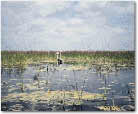Application of Stable Isotope Techniques to Identifying Foodweb Structure, Contaminant Sources, and Biogeochemical Reactions in the Everglades
|
Project Investigators:
Carol Kendall, Bryan E. Bemis, Scott D. Wankel
Project Personnel: Steven R. Silva, David P. Krabbenhoft, George Aiken, William H. Orem, William Loftus, Ted Lange, Peter Rawlik, Darren Rumbold, Larry Fink, Robert Shuford, Joel Trexler, Jerry Stober, Charles W. Holmes, Doug White, Doug Choy Project Start Date: 2000 End Date: 2004 |
| Summary |
| The primary focus of this study will be to determine the trophic structure of aquatic biota in the Everglades ecosystem, and to investigate the usefulness of carbon-isotope analyses of fatty acids as indicators of trophic position and base of the food chain. |
Please note: This project is part of the larger USGS project "Integrated Geochemical Studies in the Everglades"
Major objectives of this project are to: (1) determine the stable C, N, and S isotopic compositions of Everglades biota, (2) use bulk and compound-specific isotopic ratios to determine relative trophic positions for major organisms, (3) examine the spatial and temporal changes in foodweb structures across the ecosystem, especially with respect to the effect of anthropogenically derived nutrients and contaminants from agricultural land uses on foodwebs, (4) evaluate the effectiveness of isotopic techniques vs. gut content analysis for determining trophic relations in the Everglades, (5) evaluate the role of algae vs. detritus/microbial materials in foodwebs across the nutrient gradients, (6) work with modelers to correctly incorporate foodweb and methyl mercury (MeHg) bioaccumulation information into predictive models, and (7) evaluate the effect of STA’s on foodweb relations and MeHg bioaccumulation.
Proposals
Work Plans
Project Summaries
Data
- Everglades Isotope Data (from the data exchange pages)
Metadata
- Application of Stable Isotope Techniques to Identifying Foodweb Structure, Contaminant Sources, and Biogeochemical Reactions in the Everglades (project metadata)
- Everglades Isotope Data (data set metadata)
Publications
Abstracts
- Biogeochemical and Hydrologic Controls on Food Web Structure in the Everglades (from the GEER Conference, April 2003)
- Effects of Microhabitats on Stable Isotopic Composition of Biota in the Florida Everglades (from the GEER Conference, April 2003)
- Effects of Seasonal and Spatial Differences in Food Webs on Mercury Concentrations in Fish in the Everglades (from the 2002 AGU Spring Meeting)
- Is Food Web Structure a Main Control on Mercury Concentrations in Fish in the Everglades? (from the GEER Conference, April 2003)
- Isotopic Evidence for Spatial and Temporal Changes in Everglades Food Web Structure (from the GEER Conference, April 2003)
- Spatial and Temporal Patterns in Isotopic Composition of Aquatic Organisms at Everglades Nutrient Removal Project Sites (from the GEER Conference, April 2003)
- Spatial Changes in Redox Conditions and Food Web Relations at Low and High Nutrient Sites in the Everglades (from the GEER Conference, December, 2000)
- Tracing Food Web Relations and Fish Migratory Habits in the Everglades with Stable Isotope Techniques (from the South Florida Restoration Science Forum, May 1999)
- Using Nitrogen and Carbon Isotopes to Explain Mercury Variability in Largemouth Bass (from the GEER Conference, April 2003)
Bibliographies
Fact Sheets
Journal Articles
- Levels of mercury in alligators (Alligator mississippiensis) collected along a transect through the Florida Everglades (article available from the journal "Science of the Total Environment", 297:239-252. Abstract only; subscription is required for the full version)
- Variation in trophic shift for stable isotope ratios of carbon, nitrogen, and sulfur (article available from the journal "Oikos", 102:378-390. Abstract only; subscription is required for the full version)
Papers
- Binding of Mercury(II) to Dissolved Organic Matter: The Role of the Mercury-to-DOM Concentration Ratio
- Isotopic Evidence for Spatial and Temporal Changes in Everglades Food Web Structure (presented at 2003 GEER conference)
- Lessons from the Everglades: Atypical isotope patterns in a complex ecosystem
Posters
- Mapping Spatial Variability in Marsh Redox Conditions Using Biomass Stable Isotopic Compositions
- Tracing Foodweb Relations and Fish Migratory Habits in the Everglades with Stable Isotope Techniques (from the South Florida Restoration Science Forum)

